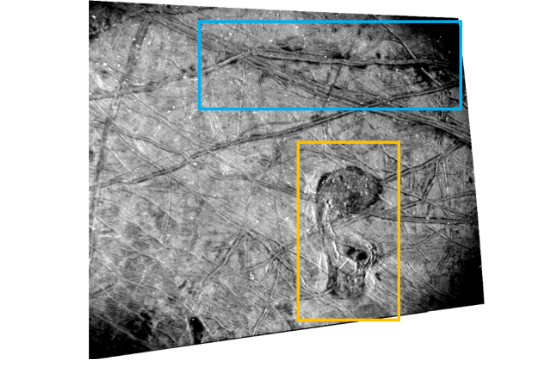Landmarks on Europa’s surface suggest the icy crust is at the mercy of the waters below. Most important, a recent visit by Juno reveals what might be plume activity, which if real would allow future missions to take a sample of the internal ocean without needing to land.
It’s been almost two years since Juno made its closest approach to Europa, but its observations are still being analyzed. Remarkably, despite having orbited Jupiter since 2016, five images taken by Juno on September 29, 2022, were the first close-ups of Europa since the Galileo spacecraft’s last visit in 2000.
Arguably that represents a shocking neglect of one of the Solar System’s most intriguing worlds, but it might also have provided a long baseline to see what had changed.
Europa is the smoothest object in the Solar System, thanks to the constant resurfacing driven by its internal ocean. Nevertheless, it is far from featureless, and Juno spotted some steep-walled depressions 20 to 50 kilometers (12 to 31 miles) wide and fracture patterns thought to be indicative of “true polar wander”.
“True polar wander occurs if Europa’s icy shell is decoupled from its rocky interior, resulting in high stress levels on the shell, which lead to predictable fracture patterns,” said Dr Candy Hansen of the Planetary Science Institute in a statement.
The idea behind true polar wander is that the shell that rests on top of Europa’s internal ocean is rotating at a different rate from the rest of the moon. It is thought the water below is moving, and dragging the shell with it, with currents within the ocean affecting the shell’s movements. The currents in turn are presumably driven by heating within Europa’s rocky core as the gravitational tug of Jupiter and the larger moons turn Europa into a giant stress ball.
In the process, the interactions between the ocean and the ice could stretch and compress regions, creating the cracks and ridges seen since Voyager 2 visited.
Hansen is part of a team exploring Juno’s images of Europa’s southern hemisphere. “This is the first time that these fracture patterns have been mapped in the southern hemisphere, suggesting that true polar wander’s effect on Europa’s surface geology is more extensive than previously identified,” said the scientist.
Not all the changes to Europa’s maps are the result of internal ocean currents. It seems even NASA falls for optical illusions. “Crater Gwern is no more,” said Hansen. “What was once thought to be a 13-mile-wide impact crater — one of Europa’s few documented impact craters — Gwern, was revealed in JunoCam data to be a set of intersecting ridges that created an oval shadow.”
However, Juno is giving more than it takes away. The team is excited by something they are calling the Platypus for its shape, rather than because it has a bunch of features that shouldn’t go together. Ridge formations at its edge appear to collapse into it, and the team thinks this process could be caused by pockets of salt water that have partially penetrated the icy shell.

The feature, named by planetary scientists who have apparently never seen a real platypus outlined in yellow, with a region of ridges in blue.
Image credit: NASA/JPL-Caltech/SwRI
Such pockets would be exciting indirect targets for study by the Europa Clipper, but more interesting still are dark stains that may have been deposited by cryovolcanic activity.
“These features hint at present-day surface activity and the presence of subsurface liquid water on Europa,” said Heidi Becker of the Jet Propulsion Laboratory. Such activity has been confirmed in the geysers of Enceladus, but there is conflicting evidence of whether it is currently occurring on Europa.
Such activity would make it possible to sample the interior ocean for signs of life just by flying through a plume and collecting some ice flakes, without having to land, let alone drill.
Currently, polar wander might cause quite modest adjustments to the locations of features on Europa’s surface, but there is evidence that millions of years ago a shift of more than 70 degrees took place, for reasons unknown.
Source Link: NASA’s Flyby Of Europa Suggests "Something" Stirring Beneath The Ice